
Rutile Gemstone: Properties, Meanings, Value & More
 Rutile is a commonly golden or red mineral known for being an inclusion in other gemstones like rutilated quartz and for having one of the highest refractive index values of any crystal.
Rutile is a commonly golden or red mineral known for being an inclusion in other gemstones like rutilated quartz and for having one of the highest refractive index values of any crystal.
Is rutile a rare mineral? Not at all. In fact, rutile is the most common type of titanium dioxide formed naturally. That said, gem-quality rutile crystals found in facetable sizes are less common.
If you’ve ever heard of the type of quartz with golden needles piercing through it called “rutilated quartz” or gemstones that display a “cat’s eye,” then you may have come across rutile without even realizing.
But what is a rutilated gem? And what is rutile on its own? We’ll answer all your questions and more as we dive into the world of rutile and rutilated gemstones.
 Image credit: Ra'ike | Creative Commons Attribution-Share Alike 3.0 Unported license
Image credit: Ra'ike | Creative Commons Attribution-Share Alike 3.0 Unported license
What Is A Rutile Crystal?
Rutile, or “red schorl” historically, is usually seen in the jewelry world inside other gemstones. Individual crystals are considered collector’s pieces. Rutilated quartz is used as a zodiac stone for Gemini and Taurus, though.
Besides being the most common natural type of titanium dioxide, it also often contains two rare metals: niobium and tantalum.
Given its valuable composition, what is rutile used for?
Industrial Rutile Uses
The main industrial uses for rutile go toward making or extracting:
White pigment — for paint, paper, plastics, and more
Sunscreen — nanoparticles absorb UV light
Titanium metal — the mineral contains 30 percent titanium
Polarization optics — due to the high refractive qualities
Refractory ceramics — used in metallurgy for kilns, crucibles, and more
Welding electrode covering — protects metal from atmosphere and stabilizes arc
Beyond its composition, rutile’s resistance to heat, pressure, and chemicals allow it to be used for applications like refractive ceramics. Its application in polarization optics comes from its extremely high refractive index, dispersion, and birefringence.
To further put rutile’s importance into perspective: Rutile is the best and purest natural form of titanium dioxide (composed of 30 percent titanium), and titanium dioxide is used for roughly two-thirds of the world’s pigments!
That said, rutile specimens are almost always made impure by other elements, which brings us to rutile’s mineral characteristics.
Rutile Specifications & Characteristics
Rutile is a titanium dioxide mineral with the formula TiO2. The stone is the most common member of the rutile group of tetragonal oxides, which also includes cassiterite.
This mineral is one of three natural forms of titanium dioxide, beside anatase and brookite. All three are polymorphous (same chemical composition, different crystal structures), though rutile and anatase are the main forms.
Both anatase and rutile are used for white pigments, but the two differ in color and absorbance, so only rutile is used in sunscreen. Plus, among rutile, anatase, and brookite, rutile is used for gemstones the most.
When it doesn’t form needle-like crystal inclusions, rutile crystals are often prismatic and striated vertically. Multiple crystals (up to 8) can form contact twins together, occasionally creating a loop of crystals. You can also find massive or granular rutiles.
Below are the remaining rutile properties:
Mohs hardness: 6-6.5
Color: Golden, red, reddish-brown, brown, brownish-yellow, green, yellow, pale blue, violet, black, gray, grayish-black
Crystal structure: Tetragonal
Luster: Metallic, submetallic, or adamantine
Transparency: Transparent to opaque
Refractive index: 2.62-2.90 (over the limit)
Density: 4.20-4.30 (4.20-4.40 in iron-bearing, 4.20-5.60 in tantalum-bearing)
Cleavage: Good/distinct on [110], moderate on [100]; Parting on [092] and [011]
Fracture: Conchoidal, subconchoidal, or uneven/irregular
Streak: Gray-black, light brown, or light yellow
Luminescence: None
Pleochroism: Present, weak to strong dichroism shades of brown, red, yellow, and green
Optical effects: Sometimes chatoyancy
Birefringence: 0.287
Dispersion: 0.28-0.33 (extremely strong)
Next, we’ll move from individual properties into its many rutile varieties and rutilated gems.
 Pictured above: Sagenite variety of rutile
Pictured above: Sagenite variety of rutile
Types of Rutile
Let’s start with rutile varieties. Tantalum, niobium, and iron are common impurities in rutile. Iron may replace some of the titanium, and rutile may be up to 10 percent iron. This leads us to the variants:
Ilmenorutile / Niobian Rutile: Black, niobium-bearing variant
Strüverite: Black, tantalum-bearing variant sometimes containing iron and/or niobium (niobium content must be lower than tantalum content)
Nigrine: Iron-rich variant or combination of rutile and ilmenite
Sagenite: Variant with a mesh-like network of twinned crystals
“Sagenite” is also used for rutilated agate (sometimes called sagenitic agate) and other quartz or chalcedony stones containing needle-like inclusions of rutile or tourmaline.
Types of Rutilated Gemstones
Within other gems, rutile inclusions are typically needle-like crystals or microscopic fibers. These inclusions may point in multiple directions or form dense bundles that cause optical phenomena.
What gems can be rutilated? We’ll list them below, starting with the most well-known.
Rutilated Quartz
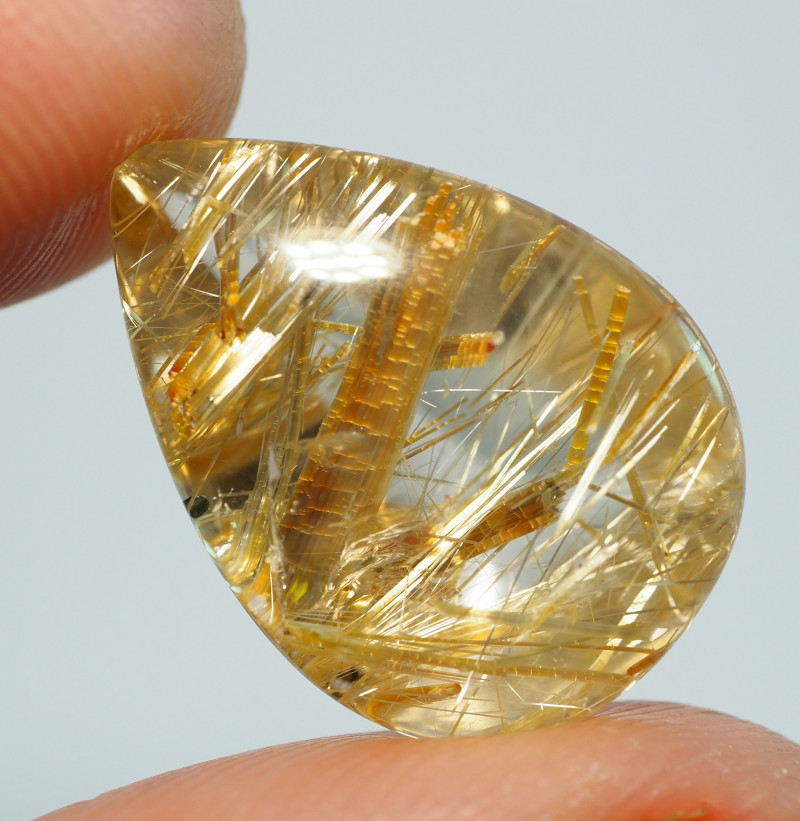
Perhaps the most popular rutilated stone is rutilated quartz, or rutile quartz. Usually, this is a clear quartz with golden rutile needles piercing the interior. The needles’ shape, color, and size differs with each stone, leading to a few varieties:
Venus Hair Stone: Variety with golden-colored rutile inclusions
Star Rutile Quartz: Variety with six groups of inclusions that extend out from a center point, forming a star
Graffiti Quartz: Clear quartz with black rutile needles
Though rutilated quartz is macrocrystalline, rutile can also appear in microcrystalline (chalcedony) varieties like agate.
Corundum (Sapphire & Ruby)
 Pictured above: Star sapphire
Pictured above: Star sapphire
Inclusions in precious gemstones like sapphire or ruby usually lower the stone's value. However, dense, parallel bunches of rutile fibers called “silk” can produce reflections of 4- or 6-rayed “stars” on the surface of either stone, called asterism, that increases value.
Ever seen “star ruby” or “star sapphire” on sale? Those are rutilated! Though many black star sapphires have hematite inclusions instead, some from Thailand have 12-rayed stars from rutile and hematite needles.
However, if rutilation doesn’t cause optical effects, jewelers may heat-treat rubies to dissolve the rutile and improve clarity.
Now, what about the “cat’s eye” effect?
Cat’s Eye Stones
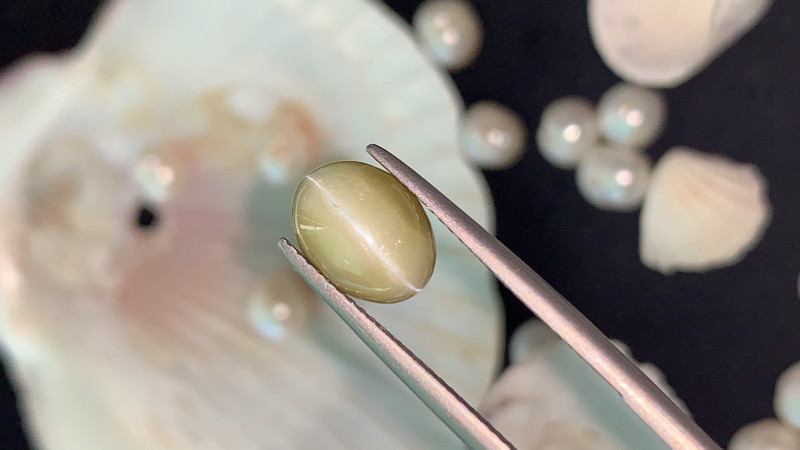 Pictured above: Cat's eye stone (chrysoberyl)
Pictured above: Cat's eye stone (chrysoberyl)
If a rutilated stone has one reflected light ray on its surface, rather than multiple rays, that’s called chatoyancy or the “cat’s eye” effect.
The strongest example is seen in chatoyant chrysoberyl, simply called “cat’s eye.” Other chatoyant stones must follow with their name (e.g. cat’s eye sillimanite).
Other chatoyant rutilated stones include:
Quartz
Tourmaline
Chatoyancy can also be caused by a stone’s inherently fibrous or layered structure, like tiger’s eye. Even individual rutile stones can be chatoyant!
Other Gemstones with Rutile
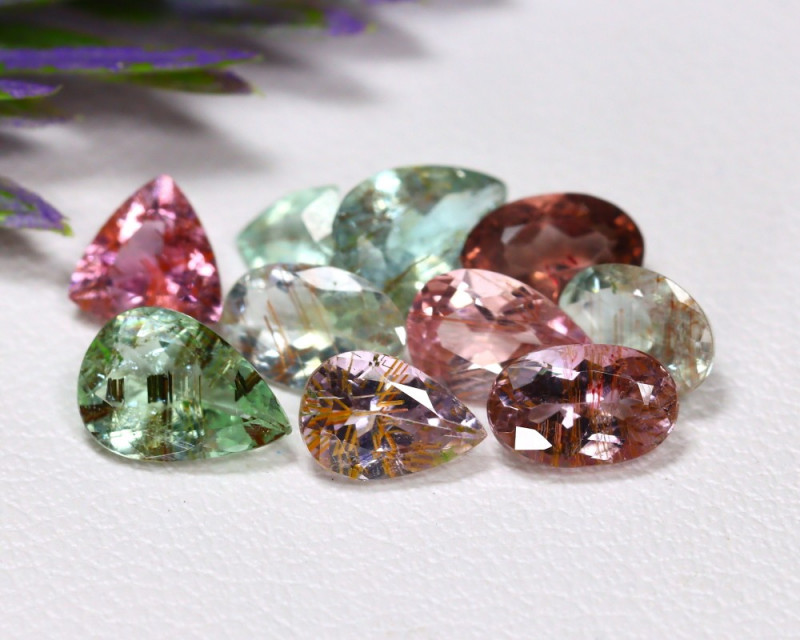 Pictured above: Tourmaline gemstones with rutile inclusions
Pictured above: Tourmaline gemstones with rutile inclusions
Plenty of gemstones commonly contain rutile but don’t display optical effects, like the quartz containing actinolite, tremolite, rutile, and mica called “witch’s finger.” Some others include:
Phlogopite
Hematite
Phew, that’s a lot of rutilated gems! Let’s shift gears to examine rutile’s symbolism.

Rutile Gemstone Meaning & History
Rutile symbolizes enlightenment, intuition, and celestial connection. Interestingly, a now-obsolete 19th-century definition of “rutilate” means “shine” or “emit rays of light.”
Medieval European fortune tellers believed rutile was a spiritual bridge, using rutilated quartz to see into a client’s past, present, and future.
The rutile in rutilated quartz is also called “hair of the angels” or “Cupid’s arrows” and is connected to various goddesses.
To ancient Greeks and Romans, it was “the hair of Venus (or Aphrodite),” goddess of beauty and love. Some legends even claim rutilated quartz was formed when the strands of the goddess’s hair fell and were preserved by mythical creatures or ice.
During the Middle Ages, Vikings believed rutile came from Freyja, one of the central goddesses in Norse mythology. She’s similar to Venus in her affiliation with beauty, love, and the finer things in life.
 Pictured above: Titania (synthetic rutile) | Image Credit: James St. John at Flickr
Pictured above: Titania (synthetic rutile) | Image Credit: James St. John at Flickr
History
Rutile’s name derives from the Latin term rutilus for “reddish,” after the originally studied specimen’s color. German geologist Abraham Gottlob Werner chose the name in 1800 with his description, but it wasn’t the first name.
The first description of rutile came from Austrian mineralogist & metallurgist Ignaz (or Ignatius) von Born in 1772, based on Slovakian specimens. He named it “Basaltes crystallisatus ruber,” Latin for “red crystalline schorl.”
In 1783, French mineralogist Jean-Baptiste Louis Romé de l'Isle found a rutilated quartz in Madagascar and named the rutile “schorl rouge ou purpre” (French for “red or purple schorl”).
Twelve years later in 1795, German chemist Martin Heinrich Klaproth described titanium (before it was officially known) from present-day Slovakian rutile that he dubbed “hungarischen rother schörl” (German for “Hungarian red schorl.”)
Shortly after in 1796, Genevan geologist Horace Bénédict de Saussure provided a description of a Swiss twinned rutile he called “sagenite” — from the Greek or Latin sagena meaning “net.”
Also in 1796, Irish geologist Richard Kirwan named rutile “titanite” (now used for sphene). French mineralogist René Just Haüy similarly named rutile “titane oxydé” (French for “oxidized titanium”) in 1801.
Due to various descriptions over time, rutile’s type locality has been debated. Though it was initially considered Horcajuelo de la Sierra from Werner’s 1800 description, 21st-century studies showed Revúca, Slovakia, was the true type locality.
In modern times, rutile was first synthesized in 1948. These stones were sold as diamond simulants (with the name “Titania”) for a few years until more durable options emerged.

Rutile Healing Properties
Like the many gemstones containing it, rutile can be used as a healing stone. Red rutile, like other red gemstones, offers vitality, motivation, and passion. Golden rutile joins other yellow gemstones in promoting hope, success, and joy.
As a chakra stone, rutile benefits the entire chakra system, opening and aligning all seven energy centers so you can feel entirely balanced and receptive to positive energies.
Physical Healing
Rutile is said to help with chronic illnesses, fatigue, and low energy. It’s also believed to treat fertility issues.
Emotional Healing
Some purported emotional rutile crystal benefits include dispelling stress, shame, and phobias. Crystal healers recommend working with rutile when setting intentions to better manifest your desires.
Beyond healing, is rutile valuable? That depends on its properties.
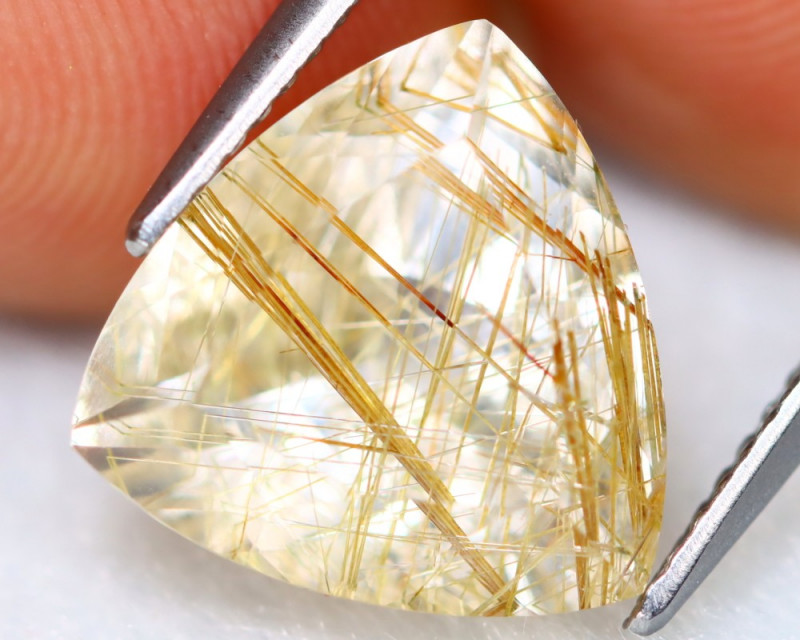
Rutile Gemstone Properties
The value of rutile gemstones depends on their color, cut, clarity, and carat weight, along with if they’re synthetic or not.
Color
Most rutile comes in autumnal shades of red, golden, brown, or black, all of which come from iron. Niobium or chromium can create green shades.
The most valuable rutile colors are vibrant golden-yellow and copper red, though rare blue and violet shades also have a market among collectors.
Cut
With a dispersion 6-times greater than a diamond, rutile with a proper faceted cut can sparkle like no other. This effect is best on synthetic rutile, though, as natural faceted stones are usually too dark in color (or too metallic in luster) to show off the dispersion.
Attractive, well-colored rutiles cut into faceted gems are extremely valuable.
If rutile is chatoyant, it must be cut en cabochon to display the effect.
Clarity
Clarity (the amount of visible inclusions in a gem) can affect transparency. Since transparent rutile is the most valuable, inclusion-free transparent stones are top-tier.
Carat Weight
Though rutile can form large enough crystals to have transparent, facetable portions, larger faceted gems become too dark. Therefore, most faceted rutile gems are under 3 carats.
Treatments & Synthetics
While natural rutile is common in collections, synthetic rutile is more common in jewelry because it’s generally more transparent with better color, helping display its dispersion.
They’re created via the Czochralski process, Becher process (using ilmenite), or flame fusion method. The result is usually free from flaws, though you may see gas bubbles sometimes.
Though natural rutile isn’t treated, a synthetic rutile gemstone may be heated to change pale yellow coloring blue. Synthetic rutiles may also be red, yellow, or brown.
In contrast to synthetics, let’s look at how rutile is formed naturally.
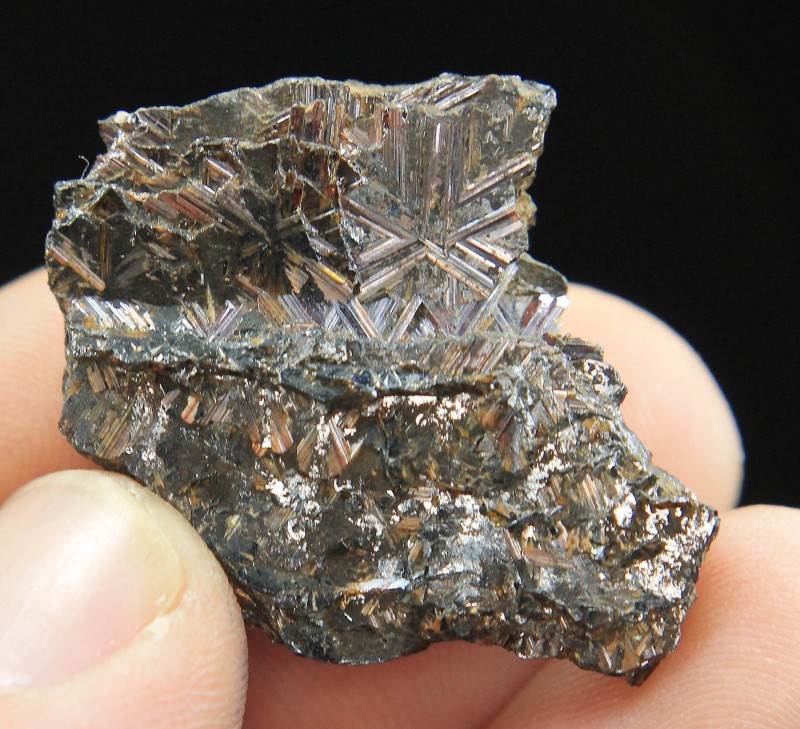
Rutile Formation & Sources
Rutile is found in igneous and metamorphic rocks, forming due to high temperature and pressure conditions. Specifically, you’ll find rutile in alpine veins, pegmatites, gneiss, schists, limestones, and detrital grains (pieces of weathered rocks).
Mining Locations
The most important current producer of rutile is Sierra Leone, supplying almost one-third of all rutile. Switzerland is significant for producing more transparent, natural rutile material.
Other important rutile sources are:
Brazil
France
Myanmar
Pakistan
Russia
Sri Lanka
USA (Arkansas, California, Georgia, North Carolina, South Dakota, Virginia)
Of course, price may be the most important aspect when considering buying rutile.
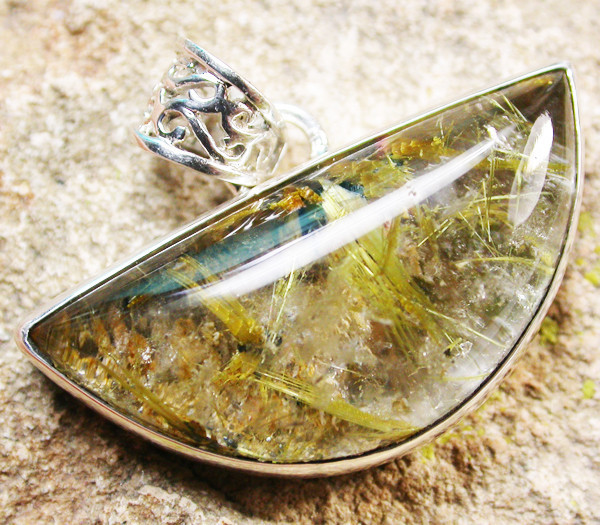
Rutile Price & Value
Rutile is pretty affordable, though the priciest options are faceted gems. Synthetic faceted gems go for around $40-$100 per carat. Natural faceted rutile is similar, ranging from $40-$90 per carat, though some are only $10 per carat or lower.
Rough rutile specimens are usually under $1 per carat. Well-formed crystals can be slightly higher, reaching around $7.50 per carat.
Cat’s eye rutile cabochons start from $13 per carat and go up to $125 per carat.
Looking for rutilated quartz? These stones are quite affordable. Multicolored stones ranging from $0.60-$15 per carat, with most on the lower end. Cabochons are around $5 per carat or lower, though rising demand has led to cabochons costing closer to $20 per carat in recent times.
Rutile Care and Maintenance
Lastly, we’ll discuss gemstone care. Rutile only has moderate hardness, so we recommend protective settings for any jewelry, particularly for vulnerable rutile rings or rutile bracelets.
Cleaning rutile is simple: Mix lukewarm water with mild soap, then using a soft toothbrush dipped in the mixture to gently scrub the stone. Dry it with a soft, dust-free cloth after rinsing away any soap residue. Store it separately from other gems.
Reveling in Rutile?
Though it’s usually a background player against other gems, rutile reminds us that you don’t need to be the center of attention for your golden shine to elevate everyone around you.
Search the Gemstone Encyclopedia
Related Auctions
Related Articles
Originally the Birthstones or gemstones were associated with a zodiac sign or the month of a individuals birth. Find out what your stone is and view the stones we have for sale
8th Feb 2021
There are dozens of quartz and chalcedony gems with various colors and patterns. Learn all about quartz properties and every type of quartz, from amethyst and agate to plasma and phantom quartz!
15th Oct 2020
Hackmanite is a pink to violet sodalite gem known for its unique color-change and luminescence. Learn why hackmanite is special, from its rare qualities to the types of hackmanite jewelry available.
28th Mar 2018
Latest Articles
Yugawaralite is a rare colorless, white, or pinkish zeolite crystal named for its discovery in Yugawara, Japan. Here we uncover the multifaceted history, properties, prices, and uses of yugawaralite.
24th Mar 2025
Simpsonite is a lesser-known mineral known on the gem market for its durability, yellow-orange color, and rarity. Discover all the properties, uses, prices, and history of simpsonite.
3rd Mar 2025
Kurnakovite is a colorless crystal related to inderite and rarely faceted but known among collectors. Explore the mineral traits, history, prices, and more in this kurnakovite guide.
17th Feb 2025
Article Categories
How To's is where you will find helpful articles from gem Rock Auctions on how to cut gemstones, select gemstones and buy gemstones.
9 Articles




